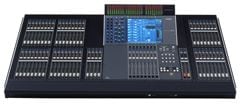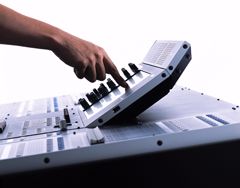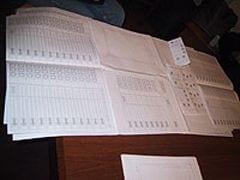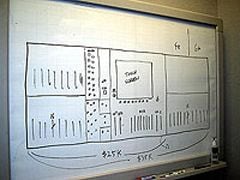M7CL
M7CL Engineers Interviews

Launched in September 2005, M7CL is Yamaha's 3rd digital mixing console designed for live sound and follows in the footsteps of the successful PM1D and PM5D.
It offers straightforward operation by a new user interface called Centralogic(TM). It is extraordinarily lightweight at less than 50kg for the 48 mono +4 stereo channel version and also much smaller than any similar spec mixer. It has the wealth of on-board features we have come to expect from digital consoles, but perhaps most significantly it has outstanding audio quality that makes it a strong contender in the discerning mid-sized console market. M7CL's entry into this last stronghold of analogue consoles indicates the beginning of a big digital groundswell coming to take over the mid and small-size sound reinforcement market. Digital mixing is becoming the sensible choice at all levels.
Yamaha's own Taku Nishikori wanted to know how and why it was created, so he interviewed the M7CL Development team at Yamaha Corporation of Japan headquarters, in Hamamatsu-city, Shizuoka, Japan.
Taku: When was the basic M7CL concept sketched out and how did it come to you?
Mick: It was around mid-summer of 2003, when we were working very long days developing PM5D. The rest of the industry now recognises Yamaha's de-facto standard position by selling over 1800 units (as of October 2005) of high-end PM1D and PM5D consoles, but back then mass market sales of digital consoles was not anticipated by many people. However, we were always thinking way ahead; about offering the advantages of digital consoles to the mid- or small-sized sound reinforcement market. So the M7CL project and the idea of digital affordability pre-dated even the PM5D launch.
Actually the small or mid-size market is one of the most reluctant for going digital. In the live audio field we have seen well-trained and high profiled engineers embrace the potential of digital mixing and it really enhances what they can do. Engineers in the recording market are familiar with a computer based environment and they have more time to manage complex digital systems. But in the small or mid-size SR market there is very limited time to manage the realities of a one-off show and it has long been thought that only a traditional analogue interface can work fast enough. Added to that preconception is the reality that in small installations and churches in the USA, they sometimes have to do the show with less-skilled voluntary operators. Yamaha would fail if it introduced a digital mixing console with a full feature set but too complicated an operation...even at a keen price.
So we thought the biggest key for M7CL was to provide an ultimately simple, easy and fast operation and to remove any digital fears from operators. It was from these discussions that the "easier than analogue" tag line evolved.
At the same time, we intended to emphasize size and weight as advantages of digital consoles. With analogue consoles you have to have all the pots and electronic parts for every channel, plus there are the outboard racks of gates, compressors, reverbs and graphic EQ's. Even mid sized analogue systems had become, let's say, "unnecessarily" big and heavy. They require too much space and too much time to install and you have to carry tons of equipment around. Modern lightweight amplifiers like Yamaha's PC series and speakers like Nexo Geo-S are a fraction of the size and weight of older systems and these benefits were greatly appreciated by the industry, so why not do the same for the mix position? Digital consoles can be much smaller and lighter since you just need DSP chips for all kinds of signal processing including mixing, EQ, compressors and effects. We aimed to achieve "less than 50% of the footprint compared to an analog system and less than 50kg weight".
However, the most important thing was that we believed we could do all this without compromising sound quality. It doesn't make sense if you show a willingness to compromise your core values in order to achieve benefits such as weight or ease of use. We all definitely agreed we must achieve the new Yamaha PM live sound quality.
Taku: "Lightweight" and "Sound quality" are easy concepts to understand, but what do you mean by "Easier than analogue"?

Nao: We didn't know what other manufacturers were working on, but from my personal point of view, I felt that they were likely to be a version of "analogue-like" operation. We thought differently. We had the advantage of a 33-year history of mixing console manufacturing, and experience of several different interface concepts but we wanted to create an all new, ultimately simple user interface which could only be achieved by extensive research and reliable digital technology. It was a great challenge and between us we came up with an elegant solution; named Centralogic(TM).
Early in development, we visited lots of venues such as US churches and small to mid-size installations worldwide. We had great results through the research. The most encouraging thing was that I got confidence with my opinion: "Analogue operation is NOT always the best in all situations".
For example, an analogue console has all the pots on the mixer surface. This is actually what they thought of as the core of "analogue intuitiveness", but this has another implication; because the "entire console"s settings are always there at all times? you can easily make mistakes when you tweak a pot surrounded by a massive number of similar pots. In reality there are many cases that an acrylic cover is attached to a mixer to prevent unwanted changes of settings especially for head amp gain and output levels. I grew even more confident about providing a feature which hides unnecessary parameters, or locks them.
The choice of touch screen was kind of natural. It works at the centre of the extremely flexible user interface and it doubles as both display and controls.
On the other hand, there are, of course, other advantages in analogue console operations. For instance, you don't need to take extra care of "modes" or "layers". We tried to create a mixing console with non-layered faders and pots, which should reduce distractions and aid concentration on the "Art of The Show" itself.
Of course we learnt many other things and have many other points to investigate, but I'd better stop talking to keep our secrets? :-)
Taku: What were the main problems you faced during the design process and creating M7CL from the Centralogic(TM) concept study?
Masaru: Even though the basic concept was very clear, it took many attempts to make it "real" as a product. It was tremendously difficult to layout adequate information on the touch screen whilst keeping enough visibility and "fun-to-drive". I remember there were many late nights!

Kotaro: I can't recall how many screen and panel layout samples I've made, but final designs were decided through lots of discussions with various sound engineers and contractors.

The number of parameters in a mixing console defies the imagination. Looking into just one input channel, you have headamp, fader, ON switch, HPF, the 12 EQ parameters, HPF, compressor, noise gate, AUX sends, and on and on? it's a huge list, and then you have to multiply it by 32 or 48 for the horizontal channel count. Then there's the output side, effects, scene memories and user management? it really was dizzying. The key was how logically and simply I could do the layout.
We believed the touch screen could handle this but, in reality we found it a double-edged sword. Relying too much on a touch screen didn't make the console "instant" enough in every situation. So we repeatedly went through the workflow which sound engineers do, each time determining how many real pots were needed and where they should be, what works well on touch screen and what works best as a switch. There were also many other aspects like size of icons, colour and contrast, etc. We've spent an unusually large amount of time on such investigations, but we think it was worth it.

Taku: The introduction of yet another new and easy-to-use user interface should be welcome, but isn't there a concern that the users of existing Yamaha digital consoles will be confused?

Mick: Centralogic(TM), in fact, has compatibility with the common user interface for all other existing Yamaha digital consoles. There is a complete inheritance that you can see; you change parameters using a virtual channel strip by selecting a channel. Centralogic(TM) provides an additional viewpoint and access to the channels by calling an 8-channel block onto the Centralogic(TM) area using the Navigation key.
I am really confident that the user interface is extremely friendly to both Yamaha users and those who are not familiar with it. Give it a try!
Taku: Where did the new cosmetic design ideas come from and are there any technological revolutions inside to achieve the weight saving, small footprint and reliability?

Kunihiro: M7CL is a very clear concept and a professional tool based around the Centralogic(TM) idea. I wanted to paint a really straightforward design layout. Function and beauty come from the simple "cross" motif; a vertically laid out "Overview" and a horizontal "Selected Channel View".
Then when you look at the desk as a whole you can see thick side cheeks expressing warmth of sound and system stability while the sharp aluminum beams represent cutting-edge technology.
In fact my designs for the M7CL cosmetics took inspiration from the "DMP7" - which was Yamaha's very first digital console back in 1987. In the very early days of digital mixing consoles, DMP7 made a big impact on the professional audio industry with its sophisticated user interface and lightweight / compact body. From a cosmetic viewpoint, it was really clean-cut and a functional beauty. I hope you feel the M7CL shares that same philosophy which Yamaha have been developing for over 18 years.
[Yoshihiro] We have been very proactive in achieving the groundbreaking mechanical design. We got various specialists involved, not only from Commercial Audio but also from tennis rackets, golf clubs and musical instruments. It's one of the great things about Yamaha - that we can draw from such diverse experiences. We put the ideas from these different points of view together and achieved all our targets: low weight, small footprint, reliability, strength and ease of maintenance. Innovative 3D CAD and structural analysis worked very well to achieve the exceptionally lightweight, yet rigid body.
Ken-ichi: During the electronic circuitry design, we aimed for a major reduction of internal wiring and a standardisation of parts. This makes it not only cost-effective but also really efficient in the assembly factory. Easy assembly is instantly reflected in significant quality control improvements: that means the product is really reliable! In addition, if a fault develops - perhaps through mistreatment or a rare part failure - the design helps save servicing time and money. Sadly you never see these contributions on the outside, but we are pleased with the result.
Taku: What was the approach to the sound quality and did anything hold up the design schedule?
Masahiro: I was surprised and delighted when Mick (Okabayashi) told me that I didn't have to reduce any costs for sound quality. So we consulted again, this time with high profile live sound engineers and we set out to create an all-new headamp circuitry that moved away from the pursuit of sterile accuracy and answered their demands for the punchy warmth and excitement that proved so successful in the PM5D consoles and now defines Yamaha's new live sound quality. We always made reference to the upper class consoles: both analogue and digital and we are proud of the comparisons. I can't tell you enough about the sound; so please have a listen and believe your ears!
Yoshihisa: Although the development schedule was quite tight, it went very well thanks to the great positive effort over the development process. We were helped by having the concept fixed so completely at a very early stage. From a practical point of view it meant we didn't have to deal with any major spec changes during the development phase. This instantly contributes to getting the highest reliability for both hardware and software design. Also, as a side effect, the staff's motivation was kept high right through 'till the end of development.
Taku: I'm curious about how you keep the software operating system so stable?
Masaru: Other manufacturers are struggling to develop DSP control using a generic OS and embedded PC from the general computing market, but we still question their stability and reliability. Our research still supports the proprietary OS made by Yamaha as the biggest contribution to mixer reliability and so we decided to utilize our mature, simple and real-time operating system.
In fact, colleagues have been continuously testing the console at the Yamaha R&D Centre, London in each phase of development from very early prototype until release. The result was... never crashed even once! We are quite satisfied with this result.
Taku: Any other nice features on M7CL?
Mick: A favourite of mine is the "Rack" page which is designed like a real rack that you can bolt any effect such as GEQ, Reverb and Delay into. The "Flex15 GEQ" module is one of the choices and its getting a great reaction from our customers. The module is a graphic equalizer that uses just half the DSP power of a full GEQ simply by limiting the number of adjustable bands to any 15 out of the 31. That means you can have two 31-band stereo GEQs just using the same amount of DSP resources as for a standard mono GEQ.
In fact we asked a UK rental company to check all of their GEQ racks just as they got back from a tour, and the result was: just 1 unit has been adjusted more than 15 bands, out of over 30 units.
Taku: Can we have your message for our readers, Mick?
Mick: M7CL is another groundbreaking product from Yamaha. We all have confidence in its intuitiveness (easier than analogue!) and all the benefits provided by the state-of-the-art technology. Reactions about its sound quality have been extremely positive from its first owners and users.
We will always create something new through teamwork between various experts gathered from various technical fields, rather than just relying purely on "charismatic leadership". Try Centralogic(TM), listen to the sound quality, feel Yamaha technology, and enjoy mixing.
Taku: And finally guys, I have to ask, are you working on another new mixer now?
Mick: I can't possibly comment, but we're all still here aren't we!
Taku: Thank you very much.
Written by: Taku Nishikori

Written by: Taku Nishikori
Manager, Yamaha CA Support Centre Europe
Since joining Yamaha back in 1991 Taku worked as a software engineer / GUI designer for various digital mixing consoles such as the ProMix01, 02R, 03D, PM1D and so on. Currently he heads the Yamaha CA Support Centre Europe in London reinforcing Yamaha's pan-European technical support capability.






